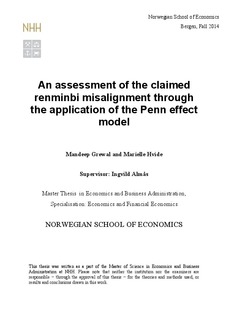An assessment of the claimed renminbi misalignment through the application of the Penn effect model
Master thesis
Permanent lenke
http://hdl.handle.net/11250/277967Utgivelsesdato
2014Metadata
Vis full innførselSamlinger
- Master Thesis [4372]
Sammendrag
In this thesis we explore the claimed renminbi misalignment through the application of the
Penn effect model. The Penn effect model estimates equilibrium exchange rates by
exploiting the empirical relation between real incomes and price levels. This thesis has three
contributions to the excising literature on the topic. Firstly, we apply the most recent and
comprehensive data set available for international price comparisons, published by the
International Comparison Program (ICP) in May 2014. This is believed to improve the
reliability of the misalignment calculation by reducing measurement errors in price levels.
Secondly, the functional form of the Penn effect is investigated in detail. Thirdly, a method
of correcting measurement errors in real incomes and price levels is presented. This is done
by exploiting the strong empirical relation between food share and income, named the
Engel’s Law.
The analysis yields two contrasting findings. First of all, the Penn effect in the ICP data is
best approximated by a dummy regression allowing for different slope and intercept between
OECD and non-OECD countries. The regression result indicates that the Chinese renminbi is
broadly in line with the real exchange rate predicted by the Penn effect. Consequently, the
Chinese renminbi can no longer be considered undervalued according to this measure.
The second main finding of the analysis does, however, cast doubt on the reliability of this
result. According to the Engel corrected incomes and price levels, the Penn effect is best
approximated by a non-linear regression function. The non-linear regression on the Engel
corrected data indicates that the renminbi is still strongly undervalued by about 50 percent.
